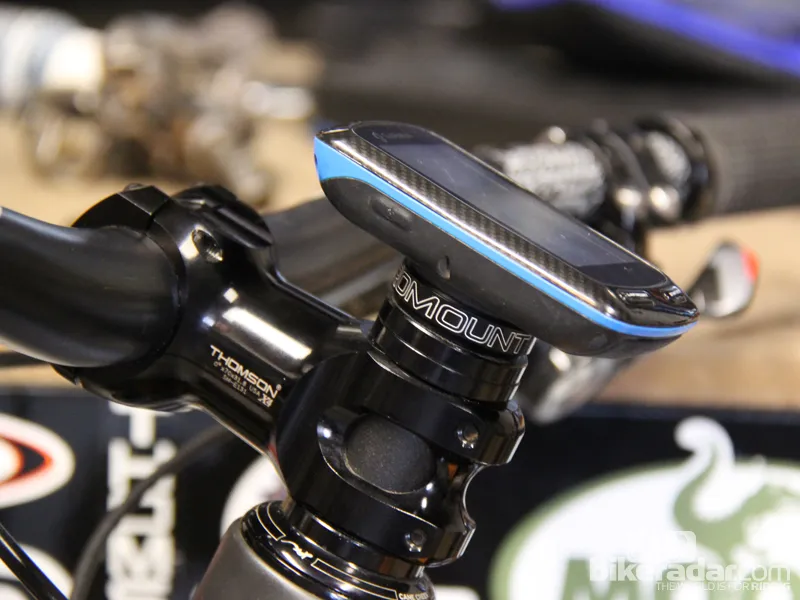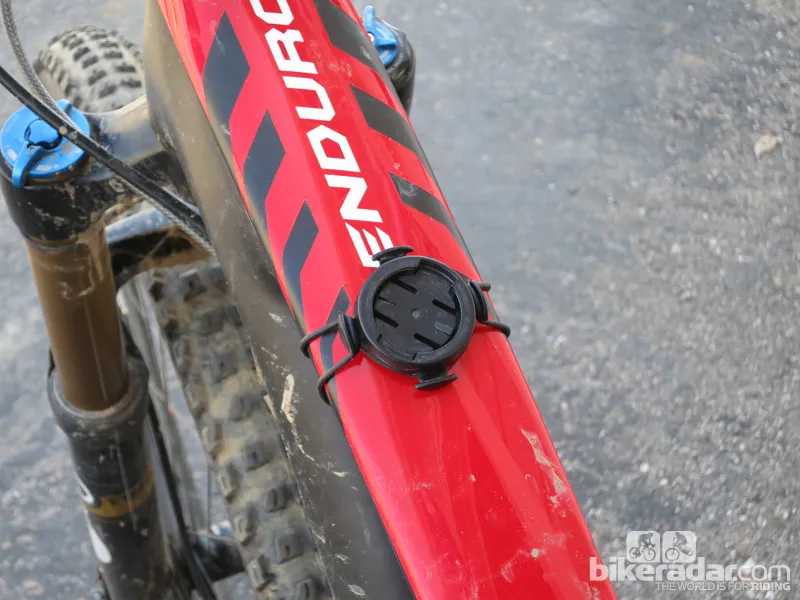Garmin cycling computers are not just tools for road riders, nor is their use limited to cross-country racers. Trail riders and enduro racers are increasingly using them to log miles and track routes. While cycling computers can be just as useful on the dirt as they are on the pavement, the demands placed on them, as well as the way riders interact with them, are quite different.
Out-front mounts can be distracting on the mountain bike, not to mention the fact they’re more exposed in the event you take a tumble. Here’s a look at several Garmin Edge 200/500 and 510/800/810 computer mounts that are suitable for mountain biking.
Garmin quick release mount

The stock mount that comes with many Garmin cycling computers allows the unit to be mounted in a variety of locations, including the handlebar, on top of the stem or even on the top tube. Some enduro racers prefer the top tube location, as it keeps the computer safe in the event the bike goes tumbling away from them.
The downside of this approach is that it’s very hard to view while riding. Other negatives include the fact that the rubber O-rings used to secure the mount are prone to slipping and can become brittle in cold weather.
- Highs: allows for multiple mounting options
- Lows: prone to slipping, O-rings prone to breaking
- Best for: Riders who want to get creative with mounting location such as on the top tube
Pro Mount Billet - Enduro Mount

The Australian component company Pro Mount Billet has developed a Garmin mount that takes the place of your top cap. The Enduro Mount consists of two pieces: the first acts as the compression cap for the headset, while the second piece screws into the first to hold the computer in place.
The two-piece design can be installed in a few minutes and you hardly notice it when it's not being used. Plus, it works well with short (40-50mm) stems.
On the downside, the Enduro Mount does position the computer higher than other Garmin mounts — on more than one occasion I chest-bumped my computer during technical climbs.
- Highs: Solid interface, centrally-located, ideally-suited to use with short stems
- Lows: Places the computer pretty high if positioned on top of spacers, likely to “chest bump” the computer during technical climbs
- Best for: Enduro racers and trail riders using short stems with no spacers on top
Tate Labs – Bar Fly 3.0

The Bar Fly 3.0 is a good all-around mount for most mountain bikers. At 17g it’s very light and the raised arm allows it to work well with flat or riser handlebars.
Part of the appeal of the Barfly 3.0 is that is easy to install and remove and works just as well on road bikes as it does on mountain bikes.
- Highs: lightweight, works on a variety of bikes (MTB, CX and road)
- Lows: May have interference issues if running a short (40-50mm) stem with a stack of headset spacers on top
- Best for: Mountain bikers who want a mount they can use on any bike they own
Your pocket or hydration pack
This option is very appealing because the odds are quite good that you already own a hydration pack — and I hope you wear pants when you ride.
While it costs nothing, and offers a lever of protection that exceeds all the other options, you may experience interference issues. The lack of easy access to your device may mean you’re less likely to use it, too.
- Highs: affordable (as in free), protects your expensive computer
- Lows: More likely to experience interference issues, limited accessibility
- Best for: Riders more interested in tracking total distance than specific segments
A GPS watch
Our own Robin Weaver (and former mountain bike racer) prefers to ride with a Garmin Forerunner 210 watch. Designed for runners, the Forerunner 210 records your ride with elevation, route and time information similar to a bike Garmin, but the interface is fairly run-specific.
This approach definitely takes the Garmin off the bike, though!
- Highs: Not attached to the bike at all, easy to use and transport
- Lows: Interface is likely to be run specific, unless you invest in a high-end triathlon model, which is likely overkill
- Best for: Riders who like the convenience of a watch and don't need many on-the-bike metrics
What do you think: Do you mountain bike with a Garmin? If so, what’s your preferred mounting method?







